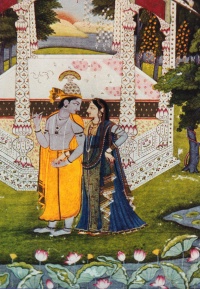Krishna: Difference between revisions
No edit summary |
No edit summary |
||
| Line 4: | Line 4: | ||
|Jug ḝuĝpur ĝiĝ bẖaram bẖarmĝiĝ har gopī kĝnĥ upĝė jīo. | |Jug ḝuĝpur ĝiĝ bẖaram bẖarmĝiĝ har gopī kĝnĥ upĝė jīo. | ||
|The Brass Age of Dwaapar Yuga came, and people wandered in doubt.<br>The Lord created the Gopis and Krishna.}} | |The Brass Age of Dwaapar Yuga came, and people wandered in doubt.<br>The Lord created the Gopis and Krishna.}} | ||
Krishna, in Gurmat, is word which is used for Mann. Krishna is black in colour and Mann is too black. Gurmat has a different view, '''Krisna''' is spirit which born on the earth and which plays on bank of Yamuna (The Path of Yamm = Manmatt). Every person is Krisna and Ram is present in every person. Even hindus are not able to say that both are different but as they did not understand their concept and made Brindaban, Dwarka, Ayodhya outside how could they say them one? Gurmat said Barindaban is Inside, Dwarka is inside human, spirit is inside and Ram is inside, now Gurmat the Path of Wisdom have proved Krisna and Ram same. Krisna is inside us and ram is inside us only. | |||
'''Krishna''', in hinduism, born in Dwapar yug is a deity worshipped across many traditions of [[Hinduism]]. He is usually depicted as a young cowherd boy playing a flute (such as in the Bhagavata Purana) or a youthful prince giving philosophical direction (as in the Bhagavad Gita). Most commonly within Hinduism, Krishna is worshipped as an avatar of Vishnu, who is considered the Supreme God by the Vaishnava schools. Within Gaudiya Vaishnavism Krishna is worshipped as the source of all other avatars (including Vishnu). Krishna and the stories associated with him appear across a broad spectrum of Hindu philosophical and theological traditions. Though they sometimes differ in details reflecting the concerns of a particular tradition, some core features are shared by all. These include a divine incarnation, a pastoral childhood and youth, and life as a heroic warrior and teacher. | '''Krishna''', in hinduism, born in Dwapar yug is a deity worshipped across many traditions of [[Hinduism]]. He is usually depicted as a young cowherd boy playing a flute (such as in the Bhagavata Purana) or a youthful prince giving philosophical direction (as in the Bhagavad Gita). Most commonly within Hinduism, Krishna is worshipped as an avatar of Vishnu, who is considered the Supreme God by the Vaishnava schools. Within Gaudiya Vaishnavism Krishna is worshipped as the source of all other avatars (including Vishnu). Krishna and the stories associated with him appear across a broad spectrum of Hindu philosophical and theological traditions. Though they sometimes differ in details reflecting the concerns of a particular tradition, some core features are shared by all. These include a divine incarnation, a pastoral childhood and youth, and life as a heroic warrior and teacher. | ||
{{Tuk|606|26451|ਆਪੇ ਗੋਪੀ ਕਾਨ ਹੈ ਪਿਆਰਾ ਬਨਿ ਆਪੇ ਗਊ ਚਰਾਹਾ ॥ ਆਪੇ ਸਾਵਲ ਸੰਦਰਾ ਪਿਆਰਾ ਆਪੇ ਵੰਸ ਵਜਾਹਾ ॥ | {{Tuk|606|26451|ਆਪੇ ਗੋਪੀ ਕਾਨ ਹੈ ਪਿਆਰਾ ਬਨਿ ਆਪੇ ਗਊ ਚਰਾਹਾ ॥ ਆਪੇ ਸਾਵਲ ਸੰਦਰਾ ਪਿਆਰਾ ਆਪੇ ਵੰਸ ਵਜਾਹਾ ॥ | ||
Revision as of 19:08, 24 July 2010
| ਜਗ ਦਆਪਰ ਆਇਆ ਭਰਮਿ ਭਰਮਾਇਆ ਹਰਿ ਗੋਪੀ ਕਾਨਹਹ ਉਪਾਇ ਜੀਉ ॥ |
| Jug ḝuĝpur ĝiĝ bẖaram bẖarmĝiĝ har gopī kĝnĥ upĝė jīo. |
| The Brass Age of Dwaapar Yuga came, and people wandered in doubt. The Lord created the Gopis and Krishna. |
Krishna, in Gurmat, is word which is used for Mann. Krishna is black in colour and Mann is too black. Gurmat has a different view, Krisna is spirit which born on the earth and which plays on bank of Yamuna (The Path of Yamm = Manmatt). Every person is Krisna and Ram is present in every person. Even hindus are not able to say that both are different but as they did not understand their concept and made Brindaban, Dwarka, Ayodhya outside how could they say them one? Gurmat said Barindaban is Inside, Dwarka is inside human, spirit is inside and Ram is inside, now Gurmat the Path of Wisdom have proved Krisna and Ram same. Krisna is inside us and ram is inside us only.
Krishna, in hinduism, born in Dwapar yug is a deity worshipped across many traditions of Hinduism. He is usually depicted as a young cowherd boy playing a flute (such as in the Bhagavata Purana) or a youthful prince giving philosophical direction (as in the Bhagavad Gita). Most commonly within Hinduism, Krishna is worshipped as an avatar of Vishnu, who is considered the Supreme God by the Vaishnava schools. Within Gaudiya Vaishnavism Krishna is worshipped as the source of all other avatars (including Vishnu). Krishna and the stories associated with him appear across a broad spectrum of Hindu philosophical and theological traditions. Though they sometimes differ in details reflecting the concerns of a particular tradition, some core features are shared by all. These include a divine incarnation, a pastoral childhood and youth, and life as a heroic warrior and teacher.
| ਆਪੇ ਗੋਪੀ ਕਾਨ ਹੈ ਪਿਆਰਾ ਬਨਿ ਆਪੇ ਗਊ ਚਰਾਹਾ ॥ ਆਪੇ ਸਾਵਲ ਸੰਦਰਾ ਪਿਆਰਾ ਆਪੇ ਵੰਸ ਵਜਾਹਾ ॥ |
| Āpė gopī kĝn hai piĝrĝ ban ĝpė gaū cẖarĝhĝ. Āpė sĝval sunḝrĝ piĝrĝ ĝpė vans vajĝhĝ. |
| The Beloved Himself is the milk-maid and Krishna; He Himself herds the cows in the woods. The Beloved Himself is the blue-skinned, handsome one; He Himself plays on His flute. |
- See Wikipedia article on Krishna for more information

